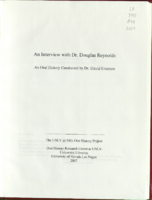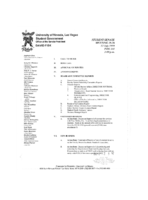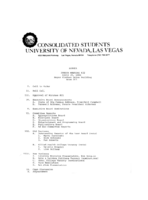Search the Special Collections and Archives Portal
Search Results

Transcript of interview with Dr. Douglas Reynolds by Dr. David Emerson, June 16, 2006
Date
Archival Collection
Description
Text

Epilogue: UNLV Yearbook, 1970
Date
Description
Yearbook main highlights: schools and departments; detailed lists with names and headshots of faculty, administration and students; variety of photos from activities, festivals, campus life, and buildings; campus organizations such as sororities, fraternities and councils; beauty contest winners; college sports and featured athletes; and printed advertisements of local businesses; Institution name: University of Nevada, Las Vegas
Mixed Content

Meeting minutes for Consolidated Student Senate, University of Nevada, Las Vegas, May 02, 2005
Date
Archival Collection
Description
Text
Pamela Jones Brown oral history interview
Identifier
Abstract
Oral history interview with Pamela Jones Brown conducted by Claytee D. White on June 12, 2019 for the Boyer Early Las Vegas Oral History Project. In this interview, Brown discusses her upbringing in Nashville, Tennessee and moving to Las Vegas, Nevada in 1968. She remembers her career as a school teacher, her employment for the Public Broadcasting Service (PBS), and writing about the history of African Americans in the United States. Lastly, Brown talks about the research behind her publications, African Americans migrating to the western United States, and early Las Vegas history.
Archival Collection

Meeting minutes for Consolidated Student Senate University of Nevada, Las Vegas, July 12, 1999
Date
Archival Collection
Description
Text
Thomas T. Beam Engineering Complex Photograph Collection
Identifier
Abstract
The Thomas T. Beam Engineering Complex Photographs (1988, 2006) mainly contains photographs and negatives of Building B of the Thomas T. Beam Engineering Complex construction in 2006. Photographs were taken by David Emerson who served positions within the University of Nevada, Las Vegas as Dean of the College of Science, Math, and Engineering; Dean of the College of Sciences; and as emeritus professor. Other materials in this collection include photographs of Lied Library and a photograph of Building A of the Thomas T. Beam Engineering Complex from 1988. The photograph includes a personal note to Emerson by Tate Snyder/Kittrell Garlock Architects, the architectural firm responsible for designing and building the Thomas T. Beam Engineering Complex.
Archival Collection
Stephen Nasser Papers
Identifier
Abstract
The Stephen Nasser Papers (1992-2018) mainly contain letters written from school children to Nasser who travels to schools, churches, and organizations around Las Vegas, Nevada to share his story of surviving the Holocaust during World War II. Materials in this collection document his captivity in various prison camps and includes photographs, awards, and newspaper clippings. Also included are speeches given by Nasser and book reviews and a teacher's guide of his book My Brother's Voice written by students of Dixie College, St. George, Utah. This collection includes a copy of
Archival Collection

Meeting minutes for Consolidated Student Senate, University of Nevada, Las Vegas, April 29, 1980
Date
Archival Collection
Description
Text

Photograph of Clark County High School students and staff, Las Vegas, 1912
Date
Archival Collection
Description
Image

